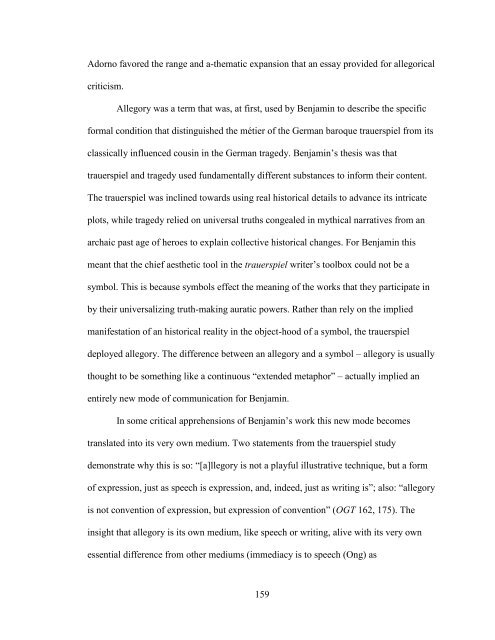TABOO: THE ACTUAL MODERNIST AESTHETIC, MADE REAL A ...
TABOO: THE ACTUAL MODERNIST AESTHETIC, MADE REAL A ...
TABOO: THE ACTUAL MODERNIST AESTHETIC, MADE REAL A ...
You also want an ePaper? Increase the reach of your titles
YUMPU automatically turns print PDFs into web optimized ePapers that Google loves.
Adorno favored the range and a-thematic expansion that an essay provided for allegorical<br />
criticism.<br />
Allegory was a term that was, at first, used by Benjamin to describe the specific<br />
formal condition that distinguished the métier of the German baroque trauerspiel from its<br />
classically influenced cousin in the German tragedy. Benjamin‟s thesis was that<br />
trauerspiel and tragedy used fundamentally different substances to inform their content.<br />
The trauerspiel was inclined towards using real historical details to advance its intricate<br />
plots, while tragedy relied on universal truths congealed in mythical narratives from an<br />
archaic past age of heroes to explain collective historical changes. For Benjamin this<br />
meant that the chief aesthetic tool in the trauerspiel writer‟s toolbox could not be a<br />
symbol. This is because symbols effect the meaning of the works that they participate in<br />
by their universalizing truth-making auratic powers. Rather than rely on the implied<br />
manifestation of an historical reality in the object-hood of a symbol, the trauerspiel<br />
deployed allegory. The difference between an allegory and a symbol – allegory is usually<br />
thought to be something like a continuous “extended metaphor” – actually implied an<br />
entirely new mode of communication for Benjamin.<br />
In some critical apprehensions of Benjamin‟s work this new mode becomes<br />
translated into its very own medium. Two statements from the trauerspiel study<br />
demonstrate why this is so: “[a]llegory is not a playful illustrative technique, but a form<br />
of expression, just as speech is expression, and, indeed, just as writing is”; also: “allegory<br />
is not convention of expression, but expression of convention” (OGT 162, 175). The<br />
insight that allegory is its own medium, like speech or writing, alive with its very own<br />
essential difference from other mediums (immediacy is to speech (Ong) as<br />
159
















